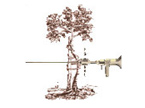 Tearing ligaments in both knees didn’t slow down Pamela Snyder, 32. An energetic athlete, Pam first tore the anterior cruciate ligament (ACL) in her right knee playing soccer in high school. Then in college she tore the ACL in her left knee playing flag football. At the time, doctors advised her not to have surgery since the procedure was still considered risky.
Tearing ligaments in both knees didn’t slow down Pamela Snyder, 32. An energetic athlete, Pam first tore the anterior cruciate ligament (ACL) in her right knee playing soccer in high school. Then in college she tore the ACL in her left knee playing flag football. At the time, doctors advised her not to have surgery since the procedure was still considered risky.
Over the next few years, Pam continued an active life, running and doing karate. During the summer of 2000 while practicing karate, Pam jumped and kicked, then landed on her left leg. Without an ACL, it promptly gave out on her. She had torn more cartilage in her knee, and her meniscus had flipped up and lodged in her joint, preventing her from bending her leg.
In August, Pam’s doctor was able to arthroscopically replace the ACL with an allograft ligament and affix it with allograft interference screws. Two to three weeks after surgery, Pam was in the gym for rehabilitation. “I healed so much faster than the autograft patients in therapy,” Pam said. “I got my flexibility back faster and made progress much more quickly than people who used their own tissue in surgery.” Although her karate days are over, Pam is back to running five miles at a time, and she continues to lift weights in the gym.
 If your physician is recommending an allograft implant in your upcoming surgery, you probably have many questions. This brochure gives you answers to the most common questions about allograft. Please ask your physician if you need more detail before making your decision.
If your physician is recommending an allograft implant in your upcoming surgery, you probably have many questions. This brochure gives you answers to the most common questions about allograft. Please ask your physician if you need more detail before making your decision.
What is an allograft?
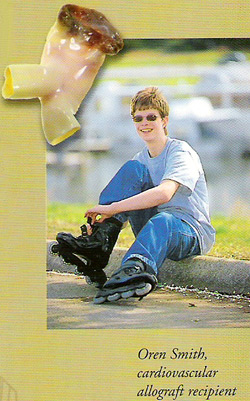 An allograft is tissue (bone, ligaments, heart valves) recovered from a human donor for transplantation into another person. Allografts have been successfully used in various medical procedures for more than 150 years; about 500,000 allografts are transplanted each year in the United States. Allograft bone is commonly used in orthopedic, spinal and oral surgeries. Burn patients, cardiac patients, urologic patients, orthopedic patients and oncology patients have all benefited from allograft transplantation.
An allograft is tissue (bone, ligaments, heart valves) recovered from a human donor for transplantation into another person. Allografts have been successfully used in various medical procedures for more than 150 years; about 500,000 allografts are transplanted each year in the United States. Allograft bone is commonly used in orthopedic, spinal and oral surgeries. Burn patients, cardiac patients, urologic patients, orthopedic patients and oncology patients have all benefited from allograft transplantation.
Where do allografts come from?
Tissues are recovered from a human donor under strict criteria. Recovery takes place in hospital operating rooms or other clean environments using surgical instruments and techniques used in hospitals for surgery. Tissue donation is strictly voluntary; the donor’s family or loved ones must consent to the donation. Donation is a gift given by the donor family to enhance the quality of life for others.
What are the benefits of allograft?
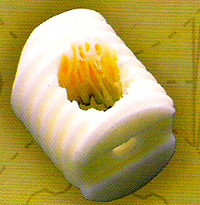 Allografts are a natural alternative to synthetic and metal implants. Unlike synthetics and metal implants, allografts incorporate into your body. Other than synthetic materials, a surgeon’s only other choice would be to take tissue from your own body (from your hip, for example) for your procedure. Using allograft eliminates this second surgery -avoiding extra pain and the chance of infection, and possibly preventing a longer hospital stay. Especially now, with the introduction of precisely shaped allograft implants, your surgeon has a wide choice of sizes and shapes to use in your surgery; with these preshaped implants, your surgery will likely be quicker.
Allografts are a natural alternative to synthetic and metal implants. Unlike synthetics and metal implants, allografts incorporate into your body. Other than synthetic materials, a surgeon’s only other choice would be to take tissue from your own body (from your hip, for example) for your procedure. Using allograft eliminates this second surgery -avoiding extra pain and the chance of infection, and possibly preventing a longer hospital stay. Especially now, with the introduction of precisely shaped allograft implants, your surgeon has a wide choice of sizes and shapes to use in your surgery; with these preshaped implants, your surgery will likely be quicker.
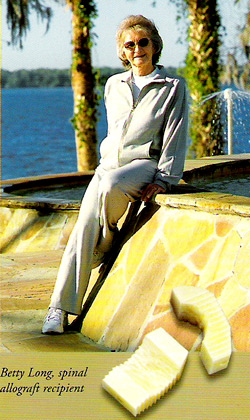 Infection, and possibly preventing a longer hospital stay. Especially now, with the introduction of precisely shaped allograft implants, your surgeon has a wide choice of sizes and shapes to use in your surgery; with these pre-shaped implants, your surgery will likely be quicker.
Infection, and possibly preventing a longer hospital stay. Especially now, with the introduction of precisely shaped allograft implants, your surgeon has a wide choice of sizes and shapes to use in your surgery; with these pre-shaped implants, your surgery will likely be quicker.
Current types of allografts used in surgery include:
- Threaded dowels and screws
- Tendons
- Bone pastes
- Pins
- Urological allografts
- Heart valves
Allografts are commonly used in the following surgical procedures:
- Spinal fusion
- Hip and knee replacement
- Anterior cruciate ligament (ACL) replacement
- Rotator cuff (shoulder) repair
- Orthopedic reconstruction due to cancer or trauma
- Surgical treatment for incontinence
- Heart valve replacement
- Ridge augmentation in dental procedures
What are Allografts and Autografts?
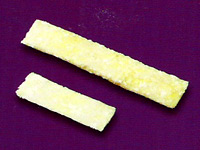 Allograft: Tissue (bone, tendons, ligaments, skin, heart valves) taken from one person for transplantation into another.
Allograft: Tissue (bone, tendons, ligaments, skin, heart valves) taken from one person for transplantation into another.
Autograft: Tissue taken from one part of a persons body for implantation into another part of their own body.
Allografts have been successfully used in various medical procedures for more than 150years; about 500,000 allografts are transplanted each year in the United States. Allograft bone is commonly used in orthopedic, spinal and oral surgeries. Many other types of allograft can help patients, too, including skin, tendons, heart valves, veins and corneal (eye) allografts. Burn patients, cardiac patients, urologic patients, orthopedic patients and oncology patients have all benefited from allograft transplantation.
How are allografts processed?
Allografts are processed in a controlled environment called a clean room – many times cleaner than a hospital operating room to minimize the risk of contaminants. Processing methods for allograft tissues include treating the tissue with chemicals like betadine, ascorbic acid and hydrogen peroxide, washing with ethanol, and finally, rinsing with sterile water. After processing, allografts are preserved by freezing or freeze-drying.
Are there risks with allografts?
Allografts offer excellent benefits; however, there is a minimal risk for disease transmission. The risk of contracting HIV from allograft tissue is exceedingly low. Since the development of the HIV antibody test in the late 1980s, there have been no reported cases of a patient contracting HIV from an allograft transplant. Allografts have been safely and successfully used for many years, and strict guidelines exist to ensure continued safety. It is important that you discuss any questions or concerns with your physician before your surgery.
How Safe are Allografts?
Every precaution is taken throughout the entire procedure of allograft recovery and processing to ensure you receive safe, high quality allografts. Extensive screening and laboratory testing is performed on all tissues at the time of recovery and on every individual allograft before it is released for surgery.
Donor Suitability
Donor tissue must meet strict criteria to be accepted into the donor program. Donors are screened for infections, cancer malignancies, autoimmune and certain neurologic disorders, drug abuse and other high risk behaviors. Additionally, the donor’s family is interviewed and the donor’s medical records are evaluated. A medical director evaluates each donor.
Donor Testing
Donor blood samples are tested in a certified laboratory for Syphilis, Hepatitis B & C and HIV. For a complete list of testing performed, please ask your physician.
Quality Assurance
Medical, social and sexual history screening of all donors is performed, as well as pre-processing blood tests. In addition, allografts are inspected before distribution, serialized and tracked electronically.
All rights reserved by / Content powered by Regeneration Technologies Inc. and Arthrex
